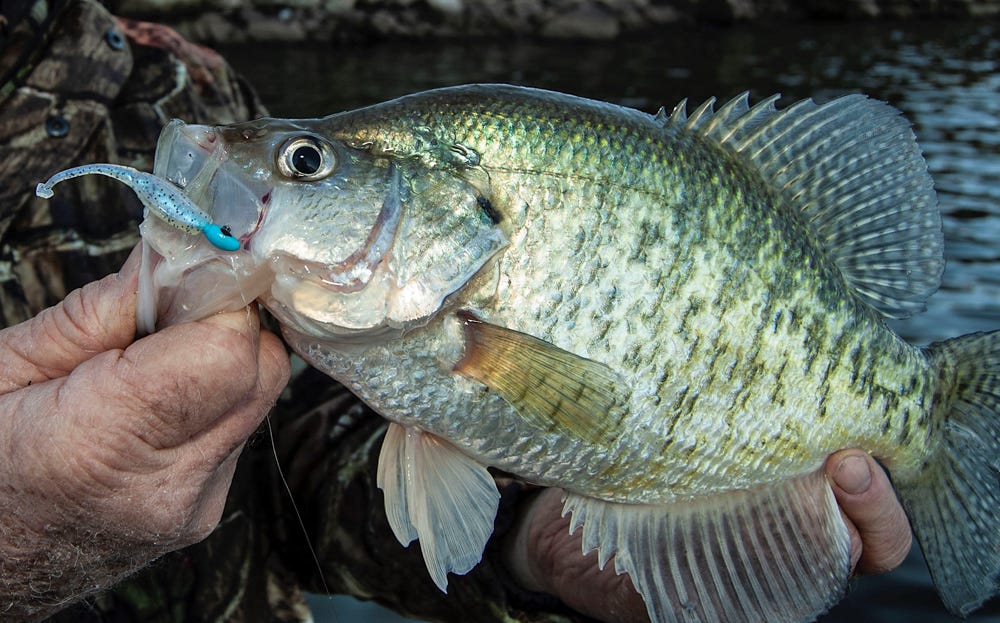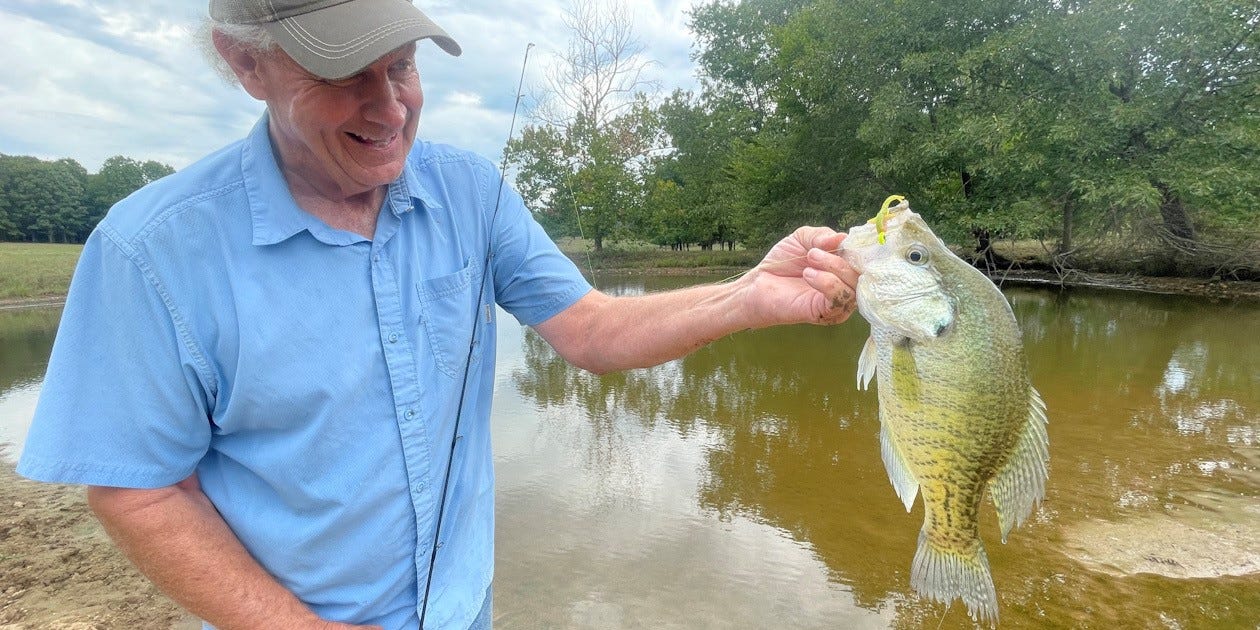- Nov 11, 2020
5 Crappie Fishing Techniques for Cool Water
Learn how to catch crappie during fall, when cooling water triggers excellent fishing action, and enjoy some of the best crappie fishing of the year.
“They’re under there – all the way back,” Terry Blankenship said with a smile as he watched his electronics. “I should be able to reach them through that hole.”
Blankenship, veteran Lake of the Ozarks crappie guide who reaches fish that are way under docks by “shooting” crappie jigs bow-and-arrow style under the docks and through gaps in the dock structure or between docks and boats, was pointing at a gap between floating sections that might have been the size of a dollar bill.
With the confidence of an NBA player draining a free throw, he knelt, drew, aimed and fired. The bait shot through the hole at the perfect angle to hit the water well under the dock before skipping all the way to the back. Almost immediately, Blankenship’s fluorescent line jumped and he set the hook with a quick downward snap. Soon after he was swinging a 1-1/2-pound crappie into the boat.
Shoot Docks
Blankenship uses many crappie fishing techniques, but shooting is his specialty, and fall is prime time for this innovative tactic. Crappie congregate under docks during fall, and the shooting technique allows you to put a jig in front of fish that cannot be reached any other way.
Big crappie relate heavily to shad during fall, and they feed well as the water gradually cools. The crappie don’t like fighting current in cool water, so Blankenship focuses fall efforts on docks in coves and creeks arms, as opposed to the main lake.
It takes a bit of practice to get the timing and aim right and know the amount of line to have out, but the basic shot isn’t really that hard. With a spinning reel bail flipped but your finger holding the line, pinch the bend of the hook (not the head or you might get jabbed!) and pull back to put a strong load in the rod. Aim and release the hook just before the line so the jig shoots forward.
Fall fish are often near the surface and feeding actively, and the biggest fish hit the fastest. “When the line jumps as soon as I flip the bail – or even before that – it’s usually a good fish,” Blankenship said.
If the fish don’t hit immediately, he’ll fish try shallow presentations before deeper ones because he doesn’t want to hook a fish that is holding deeper than others and mess up the school by fighting it through those fish.
Blankenship’s favorite fall bait is a 3-inch Slab Slayer because it effectively matches the size and profile of the prevalent shad.
Work Channel Cover
Kentucky crappie angler Brad Bowles splits fishing time between 10,000-acre Barren River Lake and the clear bluff-shrouded waters Dale Hollow. Fall is Bowles’ favorite time for two of his favorite crappie fishing techniques because the fish’s behavior is predictable, and the crappie hit decisively.
“You get to feel that tell-tale thump,” he said. “The weather changes aren’t drastic so the fishing is stable,” he said. “You can follow the fish because movements are gradual.”
Barren River Lake gets drawn down in the fall, so crappie pull off creek flats and drop deeper. They gather along old creek channel drops, holding tight to stumps and brushpile that are near the drop. Bowles targets that cover with pendulum-style presentations.
He stops his boat 25-30 feet short of a piece of cover, cast past it, flips his bail and lets the bait swing back toward him and just over the cover as it sinks. Fish hit the lure as it swings down, and if nothing does, before the jig finds bottom, Bowles just reels up and casts again.
His bait of choice is a Bobby Garland Minnow Mind’R because he believes its profile, size and glide with a pendulum presentation most effectively mimic the baitfish.
Finesse Drop
On Dale Hollow, especially, as fall progresses and the crappie turn selective in the clear water, Bowles will downsize to a 2-inch Hyper Grub or even to an Itty Bit Swim’R or Itty Bit Slab Slayer, which are only 1.5 inches long. He’ll fish the Hyper Grub on a 1/32-ounce Mo’ Glo jighead and the Itty Bit on a 1/48-ounce Itty Bit Jighead to get the slow fall needed to prompt strikes and for the right size of hook for these small baits.
However, the fish are often more than 30 feet deep besides standing timber or other cover, so getting the jig down to the fish and controlling the presentation isn’t practical with that tiny an amount of weight. His innovative crappie fishing technique is to peg a 1/8-ounce sliding weight 2 feet in front of the jig to get the lure down.
That amount weight is ideal for reaching the fish, and the weight sinks faster than the jig. When the descending weight is just above the fish, he stops it, and the Itty Bit or Hyper Grub falls slowly from two feet above the weight to two feet beneath it, fluttering right in from of the fish.
Most strikes come right after he stops the weight as the jig starts falling slowly. If Bowles doesn’t get a quick strike, he’ll keep it down there for a bit and might lift the weight a few feet and drop it again to create another slow fall. Then he’ll reel it all the way up and drop it to a slightly different spot on the same piece of cover or move to other cover.
Jig the Brush – But Not Really!
Crappie commonly pile up in brushpiles on channel edges during fall. If the top of the brush is sufficiently deep, relative to the water clarity, the most efficient way to keep a jig in front of those fish is to position the boat directly over the fish and vertical jig.
Fall crappie don’t like a lot of movement, so go easy on the jigging, neither moving the rod up and down significantly nor using sharp movements.
“Slow and steady,” stressed Dustin Holmes, who operates Action Fishing Trips on Lake Greeson in Arkansas. “You don’t really want to jig it. Once it’s in position, just lower and raise the rod slowly and smoothly.”
As the water cools through fall, the crappie move into deeper brush, with top of the brush often more than 20 feet beneath the surface on Greeson. That allows Holmes to position his boat directly over the brush.
He’ll typically give each client a rod to hold that is rigged with a Bobby Garland Baby Shad Swim’R on a 1/16-ounce jighead and have them present that barely down into the top of the brush. He’ll also set up a slip float/minnow rig for each angler to watch, with the float set to suspend the minnow just over the brush.
Holmes uses Garmin Livescope, which allows him to see the brush and fish and even his clients’ jigs, making it easy to position baits at exactly the right depth. Measuring a jig down with 1- or 2-foot pulls off the reel works well for putting jigs at a specific depth to fish brush vertically.
Cast To Brush
When Holmes has clients who are comfortable casting and can do so with good accuracy, his favorite brushpile crappie fishing technique is to stay a cast’s length back from sunken brush, cast over it, allow baits to sink to the level of the fish and then retrieve steadily.
“Don’t stop, once you start reeling,” he warned. “Stop it, and that fish is gone. That scares them.”
As with the vertical approach, Holmes favors a Baby Shad Swim’R, liking the vibration created by the swim tail. Favored colors include Monkey Milk, Blue Ice and Licorice Chartreuse Pearl.
Again, finely tuned Livescope plays an important role for Holmes. He and his clients can see the position of the fish in the brush and even their jigs, so they know when to start reeling and can watch the fish respond.
A good alternative if you don’t have that technology is to put a floating marker buoy over the brush and count down baits to the right zone before starting a retrieve. It’s easy to learn a jig’s drop rate by dropping it straight down at a known depth and counting at a steady clip. Once you’re in casting position, if you aren’t getting bites or feeling brush, add a second at a time to counts. If you’re getting snagged reduce the count.
BONUS TIPS, From Gary Dollahon, Bobby Garland Crappie Baits
- -To easily keep track of your jig’s depth, pre-measure from the end of your line and use a felt-tip marker to indicate a couple of known depths, such as 10 feet and 15 feet. Then tie a Bobber Stop onto your line so you can slide it up and down, as necessary, to identify the line payout spot and drop the jig there again.
- -Use the lightest jighead possible to achieve the desired depth and still have full feel and control of your jig.
- -Fish from the top down, instead of from the bottom up, stopping every foot or so after the initial drop to employ subtle action or deadstick your jig, until the ideal depth and presentation are determined.
Need to stuff your tackle box? Use the code GOBBLE15 for 15 percent savings on your next Lurenet order. Code expires 11/30/2020.
Whatever crappie fishing technique best suits your home waters, fall is an outstanding time to get out go crappie fishing!
5 LURE PICKS
OTHER HELPFUL TACKLE





